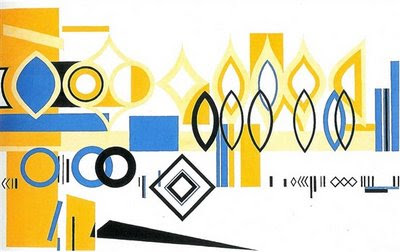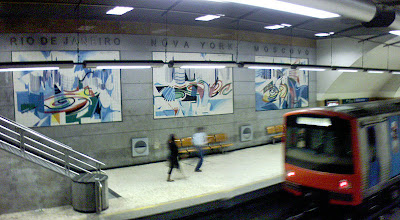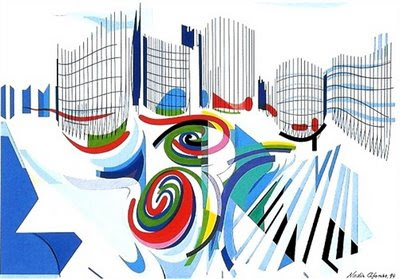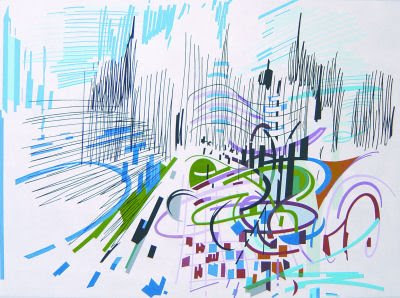
In Portugal, in 1945, there is the insertion of the chairs "Urbanism" and "History and Theory of Urbanism" in the Courses of Architecture School of Fine Arts, introducing several concepts, such as the hierarchy of road networks the nuclei and steered zoning.
At the National Congress of Architects in 1948, an event concurrent with the exhibition on "Fifteen years of Public Works," which reflected the principles of urban tradition and nationalism emerges in opposition to the idea of a new concept of city, by three architects who stood out in defense of the "Radiant City" and "Athens Charter": Viana de Lima, Arménio Losa and Lobão Vital.
Is it not possible to understand the evolution of Modern Architecture and Urbanism without taking into account their ongoing relationship with the Arts and the relationship between "Art" that during the twentieth century boosted increasingly debates, a conceptual and critical spirit. These influences were manifesting themselves in several variants, either through formal mimicry, or by a methodological and procedural parallelism.
Internationally, there was a period at the beginning of the century, where painters and architects worked side by side with the request reciprocal links to dismantle the inherited tradition. The avant-garde movements of Europe fostered an exchange of results between the experiences of Architects and Painters, which sought to change the cultural conventions.
The Bauhaus, established in 1919 in Weimar, said in his proclamation that was created for "the new building of the future, covering the architecture and sculpture and painting in this unit, and that one day will rise to the skies for more than a million workers like a crystal symbol of a new faith. "
In Portugal, it was found that integration with the adoption of codes of the Brazilian architecture of postwar architectural elements reflecting the work plasticizers, dynamism, joy and desire for freedom. The color is used as part plastic, painted surfaces, or operated through the characteristics of materials
The ceramic panels emerge as a desire to resume a traditional finish, with strong roots in the Culture and Art Deco Portuguese, but a current mode, with a contemporary attitude of "Vernacular Review of the Modern Movement." The tile panels, with speeches by various artists, thought of as a work of art integrated into architecture, they obtain a result of large plastic force in architectural production of the 50s.
In Lisbon stand out in collaboration with Almada Negreiros Pardal Monteiro, and as a remarkable example of "global work", the Block of Free Waters by Nuno Teotónio Pereira, 1956, with a color study of Frederico George, low-reliefs by Jorge Vieira, mosaics of Almada Negreiros and stained glass of Cargaleiro.
Shopping Centre Restelo of Chorão Ramalho, with the collaboration of plastic Querubim Lapa, which together with Victor Palia, intervened in several Primary Schools.
Keil do Amaral developed in Campo Grande to regionalist themes, integrating panels and ceramic sculpture pieces, with the sense of an idea of "Public Art": a mosaic of Julio Pomar, a sculpture by Canto da Maya and a ceramic Jorge Barradas.
In Porto, the students in all courses, Architecture, Painting and Sculpture, lived together intimately, not only because they have common history, and because of the three arts are considered inseparable. There was discussion of Modernism in art, and a latent nonconformity in relation to teaching classic. There are numerous examples of close collaboration of Artists in works of architecture.
Apart from that will be mentioned in more detail, we have the Amial House, designed in 1953 by Celestino de Castro, with a color study of Julio Pomar.
Also there are some partnerships between architects and artists, with some longevity, and proven with many testimonies as Arménio Losa with Augusto Gomes, José Carlos Loureiro and Agostinho Ricca with Julio Resende, Carlos Neves with Manuel Pereira da Silva, Julio de Brito and Rogerio de Azevedo with Henrique Moreira.
Interventions of this sculptor, pupil of Teixeira Lopes in Oporto Academy of Fine Arts, a current proto-modernist, occurred in various collaborations with Rogério de Azevedo, as we have seen in buildings of “Comércio do Porto” newspaper and the Hotel Infante Sagres in a model where the architecture serves to support the sculpture, also experienced in refurbishing the Rivoli Theatre, Julio de Brito in the 40s, the interior painted plaster friezes and cornice in low relief, which also collaborated the sculptor Manuel Pereira da Silva.
This partnership with Rogério de Azevedo, also are his own in 1947, a marble bas-relief in the Rialto Building, a marble bust of João de Deus, in the Garden School of the Constitution, and a sculptural element in bronze and granite in the Garden of Passeio Alegre, a tribute to Raul Brandão.
In addition to various different sculptures that punctuate public spaces in the city, in their creations for the buildings are: the "Eagle" in bronze, of the “Café Imperial” in 1936, the "Indian" in “Café Guarany”, a low-relief in marble, in the Chapel of N. S ª de Fátima a low-relief in marble, in 1939, low-reliefs in granite for the Exchange of Fish by Januario Godinho and the Cod Refrigerator, a low-relief in Stone of the St.º António Congregados Church, in 1949, low-reliefs in stone for the N. S ª da Conceição Church between 1945 and 1949, and 1957 for the Oporto City Council.
All these examples of the work of Henrique Moreira follow a more classic model of integration of Sculpture in Architecture.
In building the Silk Factory, in the Street do Monte dos Burgos, designed by Arménio Losa in 1943, there are salient in volumes, two low-reliefs of Augusto Gomes, with an integrated approach in the proposed architecture, corresponding to two figures, one male and one female, with vegetal elements and alusive to the Labor, Industry and the Sea, recurring themes of the work by this author.
“Cinema Batalha”, Artur Andrade project, dated 1944 and completed in 1947, had the artistic contributions of Júlio Pomar and Américo Braga. From the first, fresh in foyers along the stairs, the second, a bas-relief on the facade facing side the Square “Batalha”. Both interventions provoked a political and social unrest, following the complaint of the Oporto City Council to the Ministry of Interior. The works were covered with plastic paint and low-reliefs were removed the hammer and sickle.
Panel placed without any kind of shot on the flat plane of the side wall of the building, with male and female figures arranged in three heights, representing real and allegorical figures on a background here and there punctuated by stars referring to the world of film.
On the bottom the only characters include dresses and shoes in a realistic way, constituting the symbolic support of the entire composition, in allusion to the work. On the left, next to a tree of life and ahead of a harvest, a farmer with forearm secure a bunch of wheat, and stands with his right hand a sickle.
In the center, a laborer at a construction carries on his shoulders a thick iron chain that holds his left hand while his right hand, before being mutilated wielding a hammer. Even this plan, a seated figure conceived in idealized form, displays a book, an allusion to artistic creation. In the higher planes, bodies originating in traditional design in the universe seem to metaphorically hover ethereal and timeless, aesthetically integrated combination of classicism, which is characteristic of neo-realism. "
The avant-garde spirit of Arthur Andrade does not refer solely to the radicalism of the remarkable architectural design solution to the street corner where you can simultaneously connect to the urban fabric and the highlight mode, but also the insertion of a set of works of art, whether neo-realist, which appear clearly as opposed to the regime. In this case, "Synthesis of the three arts" actually contains the very formal evolution of flight from sobriety geometric shapes using more complex than the slang of the day designated as "forms of chicanery."
In the 50s, the Cavan began to be publicized and used as a coating of buildings, beginning a search to take advantage of their aesthetic plasticity, since it was possible by the additive color and type of granules of marble or limestone used to draw diverse reasons, where the colors were separated by a metal.
The residential building in the Square D. Afonso V, designed by Francisco Pereira da Costa, in 1953, has decorative elements, in Cavan, on the tops of side walls. The ground floor, to trade, has a portico that provides the transition between the private and public space of the square, corresponding to the structural system, which finds itself in a standardized geometric mesh of the remaining floors. The existence of the decorative elements on the facades side refers to a clear reference to the Modern Movement.
Primary School of the Constitution, a project of Alexandre de Sousa, Architect of the Oporto City Council between 1956 and 58, can be observed in a stairwell, a mural by Costa Martins on blue marble, which is the technique of Cavan as well as one tempera by the same author, in the cafeteria and multipurpose, a child and playful theme.
Other examples of application of Cavan, as coating aesthetic feature, is a chalet of Arménio Losa in “Avenida dos Combatentes”, the 50s, where the wall has a side panel with an abstract design, and the “Paranhos” Neighborhood, or “Outeiro”, where its design as Social Neighborhood City Council initiative of the early '60s, did not prevent its classification plastic panels in each block, and a variety of reasons geometric figuration. The creation of the “Via de Cintura Interna” came a difficult perception more closer.
Creations by Jorge Barradas in 1950 for Atlantic Palace, 1946 draft of the Society of Architects / ARS, refer to a panel disclosed in the faience, inside, and a set of ceramic panels on the roof of the arcade outside. The mythological theme, focusing on references to national folklore and practice of grassland work, fits the use to which the building was intended, the desired exaltation of nationalistic values of "Portugal beyond the Seas."
At the Church of S ª da Boavista, draft Agostinho Ricca, 1979, in addition to fifteen glazed ceramic plates of 16.5 cm, dated 1986, titled "Steps of Christ's Passion and Resurrection," there are other works of Júlio Resende, as The windows, "Christ on Calvary" and a carpet that covers the central area of the church. This case shows that, regardless of academic training of the architect, devoted to the artistic conception, when an artist involved with the versatility of disciplinary Júlio Resende, all the architectural work earns a substantial depth.
FERNANDES, José Manuel - Modernist Architecture in Portugal. Lisbon: Gradiva, 1993.
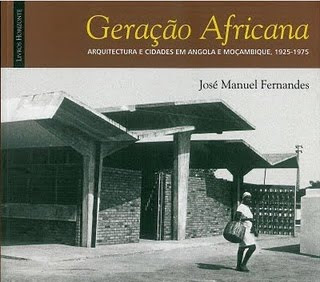


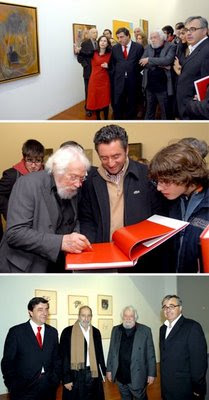




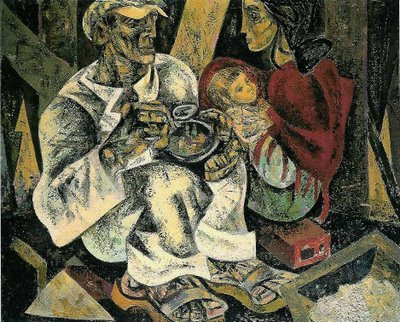


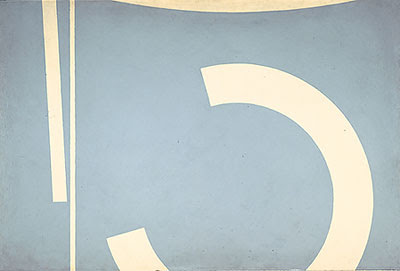
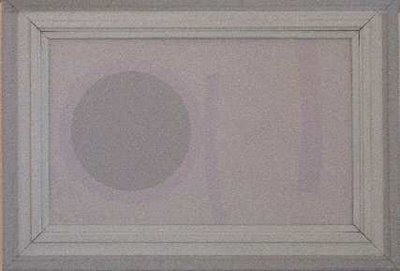

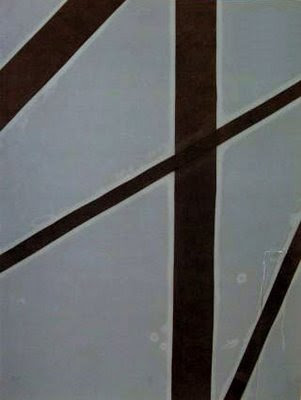
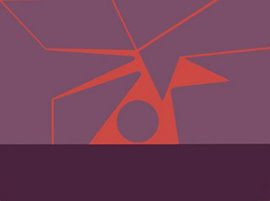

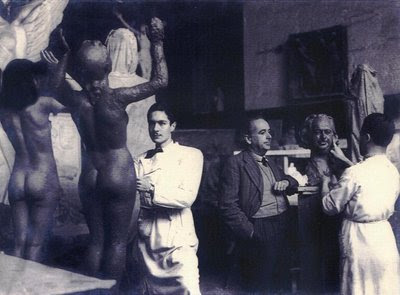



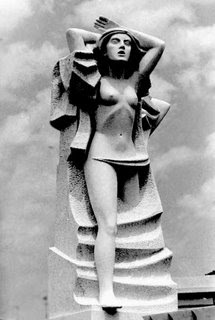

 The logic and syllogism.
The logic and syllogism. Monument to the Sculptor Henrique Moreira in Avintes.
Monument to the Sculptor Henrique Moreira in Avintes.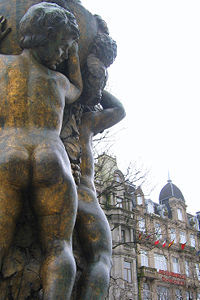
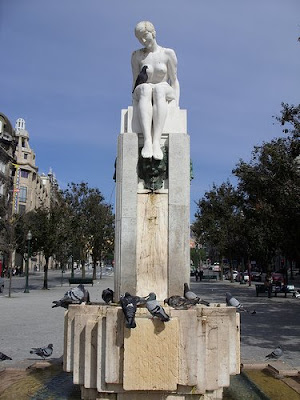











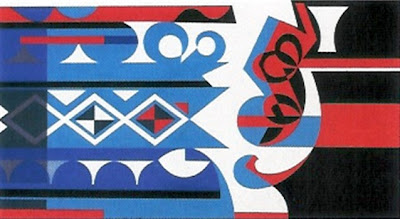
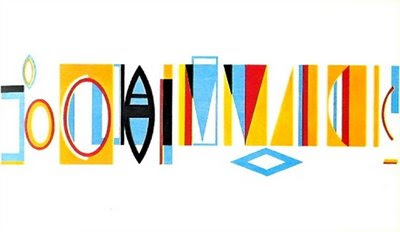 Espacillimité, 1954. Espacillimité series: still and moving paintings resulting from the pioneering Kinetic art studies.
Espacillimité, 1954. Espacillimité series: still and moving paintings resulting from the pioneering Kinetic art studies.